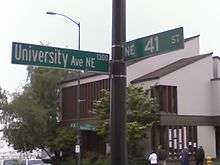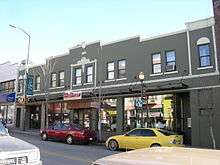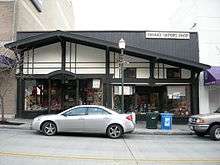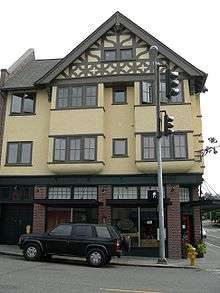The Ave
University Way Northeast, colloquially The Ave (no period;[2] pronounced /æv/), is a major street and commercial district in the University District of Seattle, Washington, located near the University of Washington (UW) campus. Once "a department store eight blocks long," The Ave has gradually turned into what now resembles an eight-block-long global food court.[3] The story of The Ave reflects the dynamics of many urban neighborhoods and the social and economic problems of countless American cities, though it is also a crossroads of diverse subcultures. It is patronized by many of the nearly 96,900 students, faculty, and staff of the UW[4] and by a population of homeless or transient individuals, most of whom are youth.
| "The Ave" | |
_southbound_from_NE_45th_Street.jpg) University Way southbound from its intersection with NE 45th Street | |
| Former name(s) | Columbus Avenue 14th Avenue NE (1891–1919) |
|---|---|
| Maintained by | Seattle Department of Transportation |
| Length | 1.2 mi[1] (1.9 km) |
| Location | Seattle, Washington |
| Coordinates | 47°39′40″N 122°18′47″W |
| South end | NE Pacific Street |
| North end | NE Ravenna Boulevard |

University Way NE is a collector (tertiary) arterial,[5] running 1.2 miles (1.9 km) from just below NE Pacific Street in the south to NE Ravenna Boulevard and Cowen Park in the north, where it turns into Cowen Place NE.[1] The street had been known as "The Ave" since the early 20th century and while it was no longer officially an avenue, the nickname stuck.
History
Originally platted as Columbus Avenue,[6] the street was renamed 14th Avenue after the neighborhood was annexed by the city in 1891. Locals came to feel that a numbered street name was inappropriate because of the thoroughfare's importance, so in 1919 the University Commercial Club held a contest that decided the new name of the street: "University Way."[7] The street once carried streetcars operated by the Seattle Municipal Street Railway that ceased in 1941.[8]
Vitality



Late in the 20th century the Ave declined significantly, due in significant part to the more competitive planning, capital investment, and popularity of University Village and Northgate Mall. From 2002 to 2004, the city and the neighborhood made some steps countering this trend by repaving the Ave and adding benches, bus bulbs, and period lighting.[9] The Ave remains at the heart of campus life for university students, and is filled with busy restaurants (mostly inexpensive), new and used book and record stores, clothing stores, and movie theatres, most densely between NE 41st and NE 50th Streets. Among these are the Varsity Theatre (1940)[10] and University Book Store (1924).[11]
The Ave is so full of salon-style establishments that it has become its own sort of macro third place. This is exemplified by the coffeehouse culture of the middle and lower Ave - with at least six cafes on the Ave or its alleys - by the remaining used bookstores with late hours, and by the annual Street Fair and weekly Saturday Farmers Market. The Ave is also home to one of Seattle's Neighborhood Service Centers,[12] outposts of the city government originally known as "little city halls."[13] Still, The Ave is also plagued with the problems of urban neighborhoods, including homelessness, drug use, and crime. A population of teenagers and young adults, often described as runaways, are referred to as "Ave Rats".[14][15]
The Ave is glorified by the Seattle hip hop group Blue Scholars in their song "The Ave" on their self-titled album. "Fuck class, get your education on the Ave" is a repeated lyric, as they portray the Ave as the last true cultural melting pot of Seattle. The business communities "improvements" of 2002 are lamented ("whatever happened to the avenue before the summer of 2002"), as they feel the unique street society of students/poets/druggies was thrown away for a conformist corporate business facade. Blue Scholars also reference several businesses on The Ave, including University Book Store and the (now closed) used record store 'Second Time Around'.
Problems
The Ave is also the major hangout for homeless and transient teens and young adults in Seattle. The local seasonal and year-round homeless population, referred to as "Ave Rats",[16] is notorious for being a particularly countercultural crowd. Their numbers have dwindled somewhat in recent years due to increased police patrols, tougher enforcement of loitering laws,[17] and designation of an Alcohol Impact Area (along with Broadway on Capitol Hill and parts of downtown neighborhoods).[18]
Another factor contributing to the homeless youth's decline was the extension of organized, gang-related criminal activity on the Ave in recent years. Several groups, whose signature graffiti "tags" can be seen throughout the U. District, contributed to the transition in drug sales from marijuana (formerly sold by homeless youth and transients) to include the organized sale of methamphetamine and cocaine. This transition has resulted in multiple incidents of gun-related violence, as well as obvious deals occurring in broad daylight.[19]
The U. District has seen these problems recur. As reported in the University District Herald in 1921, librarian "Miss Mary Baker ask[ed] for police protection from gangs of boys" who were causing what is today described as vandalism and harassment. Librarian Clara Van Sant wrote: "Men hang outside the door to smoke, gossip, and pass comments to ladies coming into the library," behavior that apparently continued through the early 1920s.[20] Recent declines have been offset by gradually increasing social and economic problems.[3] "We're not an organized shopping district. We're very much like Main Street America," said an independent retail business owner on the Ave in 2001.[21] "It's not a mall."[22]
Architecture
Ye College Inn, a Tudor Revival building at the northeast corner of NE 40th Street near the south end of The Ave, is listed on the National Register of Historic Places. The building was built in 1909 and added to the National Register in 1982.[23]
The University Heights School building on the upper Ave opened in 1902. Originally there were several other buildings on the block (the west side of The Ave between NE 50th and NE 52nd Streets), but with successive expansions, the school became the only building on its block. It was briefly known as the Morse School in 1903; from 1974, Alternative Elementary School #2 used two-thirds of the building. Its exterior was declared a city landmark in 1977. It was closed as a school building in 1989, with the alternative school moving to the Decatur School. Since 1990 it has housed the University Heights Center.[24]
The Department of Neighborhoods' inventory of historically important sites, which is not exhaustive (for example, it omits the University Heights School) lists 37 properties on University Way. Most of these are either apartment buildings or retail establishments, but the list also includes current and former theaters and the University District post office.[25]
See also
- Last Exit on Brooklyn
- Telegraph Avenue, University of California, Berkeley (UCB), Berkeley, California
- University Avenue, University of Minnesota, Minneapolis, Minnesota
- University District, University of Washington, Seattle
- Washington Square, New York University, New York
Notes
- Google (June 10, 2015). "University Way NE" (Map). Google Maps. Google. Retrieved June 10, 2015.
- Deutsch; Kelton; the local North Seattle Herald-Outlook uses the same convention.
- Lehrke
- 3,600 instructional faculty, 27,600 faculty and staff, 39,251 student enrollment on Seattle campus (Autumn 2005), 26,444 extension enrollment (non-graded programs), according to "Quick Facts". UW Home > UWIN > About the UW > UW Profile. University of Washington. April 18, 2005. Archived from the original on April 12, 2006. Retrieved April 21, 2006.
-
"Street Classification Maps". Seattle Department of Transportation. 2005. Archived from the original on June 14, 2006. Retrieved April 21, 2006.
High-Resolution Version Archived September 24, 2015, at the Wayback Machine, PDF format, 16.1 MB
Medium-Resolution Version Archived March 2, 2016, at the Wayback Machine, PDF format, 1.45 MB January 12, 2004.
Low-Resolution Version Archived June 22, 2006, at the Wayback Machine, PDF format, 825 KB January 12, 2004.
"Planned Arterials Map Legend Definitions" Archived January 17, 2006, at the Wayback Machine, PDF format. January 12, 2004.
The high resolution version is good for printing, 11 x 17. The low and medium resolution versions are good for quicker online viewing. [Source: "Street Classification Maps, Note on Accessing These PDF Files" Archived June 14, 2006, at the Wayback Machine] - Dorpat, Paul (August 26, 2007). "Stationed On The Ave". The Seattle Times. Retrieved December 17, 2018.
- O'Leary, Shannon (June 26, 2010). "The Ave: It rises, falls, rises again". Seattle Post-Intelligencer. Retrieved December 17, 2018.
- Dorpat, Paul (March 8, 2018). "Back when trolleys were bookin' it down The Ave". The Seattle Times. Retrieved December 17, 2018.
- Marmor, Kim
- "VarsityTheatre". Landmark Theatres. n.d. Archived from the original on April 22, 2006. Retrieved April 21, 2006.
- The book store was moved to The Ave following a campus building fire and the closing of a pool hall on University Way, which freed up the space it currently occupies. "Store History" (PDF). History & Highlights. Bookstore of the University of Washington. January 31, 2005. Archived from the original (PDF) on June 20, 2006. Retrieved April 21, 2006.
- University Neighborhood Service Center home page. Accessed online April 18, 2004.
- Walt Crowley (May 7, 2001). "Seattle's Little City Halls – A Snapshot History". HistoryLink. Retrieved October 11, 2007.
- Farmer, Megan; Walters, Kate; Raftery, Isolde (July 31, 2018). "Young and homeless on the Ave in Seattle". KUOW. Retrieved July 5, 2020.
- O'Leary, Shannon (June 26, 2010). "The Ave: It rises, falls, rises again". Seattle Post-Intelligencer. Retrieved July 5, 2020.
- Goedde, Brian (September 25, 2001). "Visions of the Ave". Real Change News. Archived from the original on September 29, 2006. Retrieved September 4, 2006.
- Lehrke; Binion; Borders (Borders is print published, documented opinion).
- Alcohol Impact Areas are not the same as neighborhood boundaries. See Castro (December 13, 2005)
- Castro (February 13, 2006); Castro (February 14, 2006); further may be in archives of The Daily of the U of W at Archives (by year back to 1995, off-line back to c. 1891), the North Seattle Herald-Outlook, Real Change, or the alumni magazine Columns; Seattle Post-Intelligencer and Seattle Times (archives access with free registration) are at nwsource.com.
- Burrows
- Kim; Goedde
- Lehrke; Goedde; Binion; Castro (February 14, 2006)
- Ye College Inn, Archiplanet. Accessed online April 16, 2008.
- Thompson, Nile; Marr, Carolyn J. (2002). "University Heights". Building for Learning: Seattle Public School Histories, 1862-2000. Seattle Public Schools. OCLC 54019052. Republished online by HistoryLink by permission of the Seattle Public School District: Seattle Public Schools, 1862-2000: University Heights, HistoryLink, September 12, 2013, retrieved January 1, 2018
- Historical sites: Search results for University Way, Seattle Department of Neighborhoods. Accessed April 18, 2008
Bibliography
- Binion, Andrew (June 6, 2002). "Crime, kids and customers". The Daily of the University of Washington. Retrieved July 14, 2006.
- Borders, Tim (February 26, 2002). "Shady Business in the U-District". Right Turn. Associated Students of the University of Washington. Retrieved July 14, 2006.
Right Turn is "a student-run publication at the University of Washington that gives voice to conservative and libertarian views on campus." - "Right Turn". Retrieved November 26, 2006. - Deutsch, Joan, Local News Editor. (206)464-2214. Quote from The Seattle Times Style Rules, in-house publication. The Seattle Times since 1896 [Masthead, editorial page]. May cf. Karen Cater, News Editor, same phone.
- Dorpat, Paul (May 2002) [June 18, 2001]. "Seattle Neighborhoods: University District -- Thumbnail History". HistoryLink.org Essay 3380. Retrieved April 21, 2006.
Dorpat referenced Seattle: Now and Then Vols. 1, 2, and 3. Seattle: Tartu Publications, 1984, 1988;
Walt Crowley and Paul Dorpat, "The Ave: Streetcars to Street Fairs", typescript dated 1995 in possession of Walt Crowley and Paul Dorpat, Seattle, Washington;
Walt Crowley, Rites of Passage. Seattle: University of Washington Press, 1995;
Cal McCune, From Romance to Riot: A Seattle Memoir. Seattle: Cal McCune, 1996;
Roy Nielsen, UniverCity: The City Within City: The Story of the University District Seattle: University Lions Foundation, ca. 1986;
Clark Humphrey, Loser: the Real Seattle Music Story. Portland, OR: Feral House, 1995. - Kelton, Alana, News Editor. (206)448-8154. Quote from Seattle Post-Intelligencer In-House Style Guide intranet reference tool. Seattle P-I since 1863 [Masthead, editorial page].
- Kim, Gina (February 10, 2001). "Empty storefronts litter 'the Ave'". Business & Technology. The Daily of the University of Washington. Retrieved July 14, 2006.
- Lehrke, Dylan Lee. "The Ave at the Crossroads: The decline of the Ave". The Daily of the University of Washington. pp. 2001–04–18. Retrieved July 14, 2006.
- Marmor, Jon (December 1995). "Once Seattle's Second Main Street, the Ave. Has Fallen on Hard Times. Can the UW and Local Community Save What's Left?". "The Fall (and Rise?) of the 'Ave.'". Columns. Retrieved April 21, 2006.
Alumni magazine. - Samson, Karl. "Big Time Brewery and Alehouse". Retrieved November 15, 2005, April 21, 2006. Links to "Seattle's Original Brewpub". Selection from Samson, Karl. Frommer's Seattle 2006 [Title incremented annually each January]. [City]: Wiley, 2006. ISBN 0-7645-9587-3
- "Street Classification Maps". Seattle Department of Transportation. 2005. Archived from the original on June 14, 2006. Retrieved April 21, 2006.
High-Resolution Version, PDF format, 16.1 MB
Medium-Resolution Version, PDF format, 1.45 MB January 12, 2004.
Low-Resolution Version, PDF format, 825 KB January 12, 2004.
"Planned Arterials Map Legend Definitions", PDF format. January 12, 2004.
The high resolution version is good for printing, 11 x 17. The low and medium resolution versions are good for quicker online viewing. [Source: "Street Classification Maps, Note on Accessing These PDF Files"] - "Store History" (PDF). History & Highlights. Bookstore of the University of Washington. January 31, 2005. Archived from the original (PDF) on June 20, 2006. Retrieved April 21, 2006.
- "VarsityTheatre". Landmark Theatres. n.d. Archived from the original on April 22, 2006. Retrieved April 21, 2006.
Further reading
| Wikimedia Commons has media related to University Way, Seattle. |
- Jon Marmor, "The Fall (and Rise?) of the 'Ave.'", "Once Seattle's Second Main Street, the Ave. Has Fallen on Hard Times. Can the UW and Local Community Save What's Left?", Columns (University of Washington alumni magazine), December 1995. Analysis.
